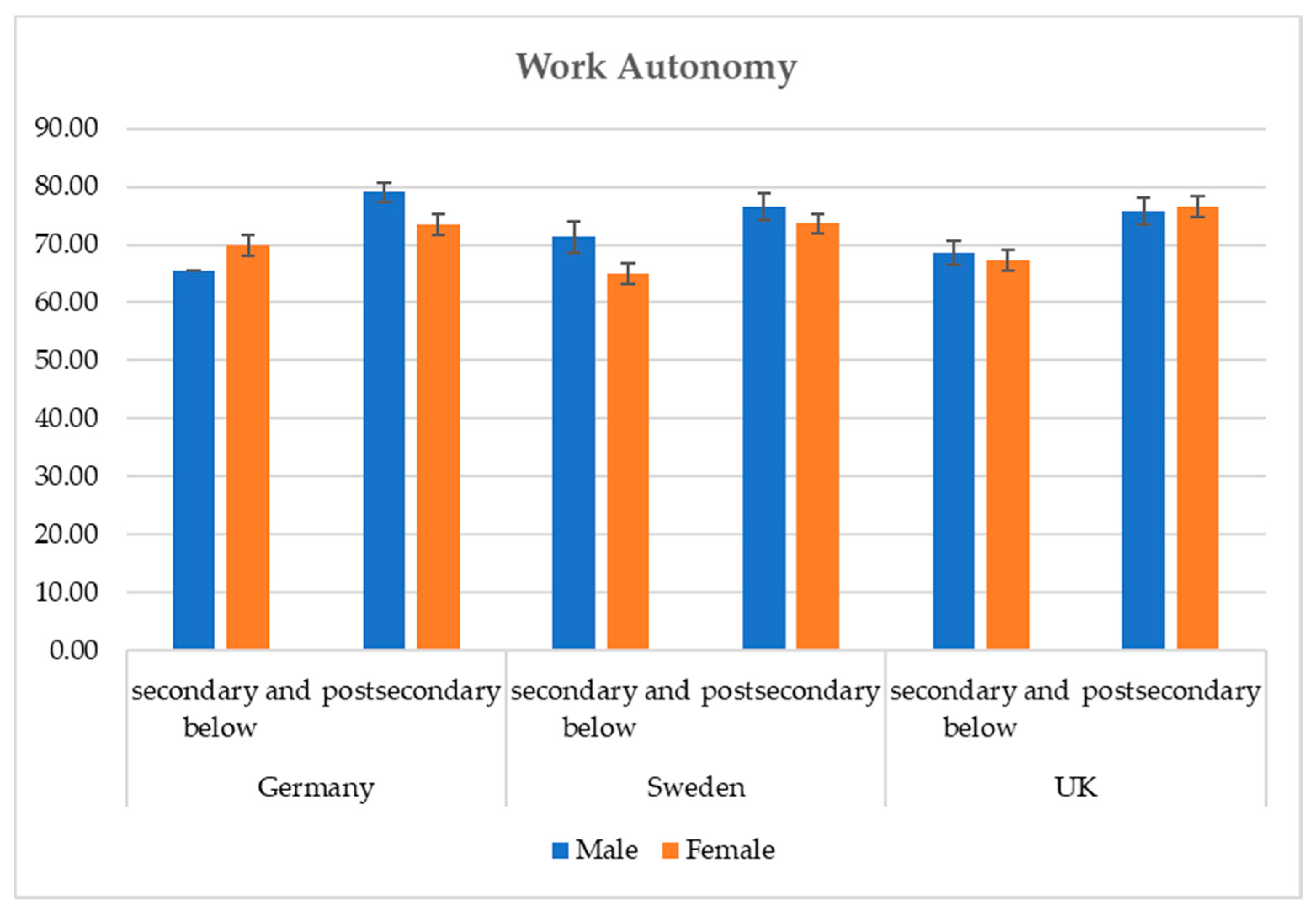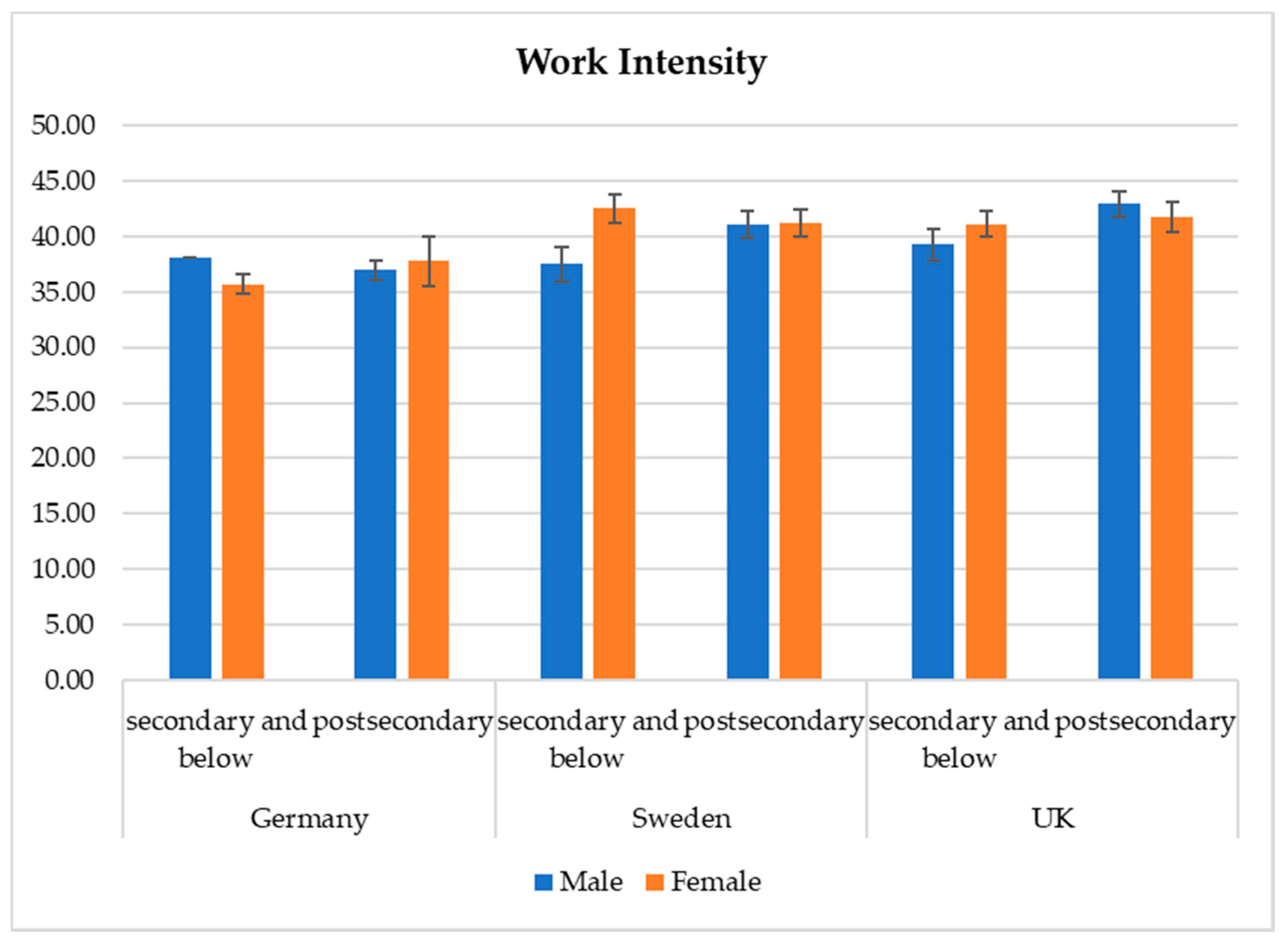Gender, Educational Attainment, and Job Quality in Germany, Sweden, and the UK: Evidence from the 2015 European Working Conditions Survey
Abstract
:1. Introduction
2. Theoretical Framework
2.1. Defining Job Quality
2.2. Gender and Working Conditions
2.3. Variance across Country Regimes
2.4. Educational Systems
2.5. Education Attainment and Job Quality
2.6. Research Hypothesis
3. Method
3.1. Measures
3.1.1. Dependent Variables
3.1.2. Independent Variables
3.1.3. Control Variables
3.2. Analysis Procedures
4. Results and Discussion
4.1. Results
4.2. Conclusions and Discussion
Author Contributions
Funding
Institutional Review Board Statement
Informed Consent Statement
Data Availability Statement
Acknowledgments
Conflicts of Interest
References
- Rubery, J.; Grimshaw, D. The Organization of Employment: An International Perspective; Palgrave Macmillan: New York, NY, USA, 2003. [Google Scholar]
- United Nations Conference on Environment; Development AGENDA 21 (1992). Available online: https://sustainabledevelopment.un.org/content/documents/Agenda21.pdf (accessed on 1 September 2021).
- Esping-Andersen, G. The Three Worlds of Welfare Capitalism; Princeton University Press: Princeton, NJ, USA, 1990. [Google Scholar]
- Lott, Y. Working-time flexibility and autonomy: A European perspective on time adequacy. Eur. J. Ind. Relat. 2014, 21, 1–16. [Google Scholar] [CrossRef]
- Smith, M.; Piasna, A.; Burchell, B.; Rubery, J.; Rafferty, A.; Rose, J.; Carter, L. Women, Men and Working Conditions in Europe; European Foundation for the Improvement of Living and Working Conditions: Dublin, Ireland, 2013. [Google Scholar]
- Green, F. Decent Work and the Quality of Work and Employment. In Human Resources and Population Economics; Zimmermann, K.F., Ed.; Online; Springer: Dordrecht, The Netherlands, 2021. [Google Scholar]
- Verhofstadt, E.; De Witte, H.; Omey, E. Higher educated workers: Better jobs but less satisfied? Int. J. Manpow. 2007, 28, 135–151. [Google Scholar] [CrossRef]
- Feldman, D.C.; Leana, C.R.; Bolino, M.C. Underemployment and relative deprivation among re-employed executives. J. Occup. Organ. Psychol. 2002, 75, 453–471. [Google Scholar] [CrossRef] [Green Version]
- Wu, C.H.; Luksyte, A.; Parker, S.K. Overqualification and subjective well-being at work: The moderating role of job autonomy and culture. Soc. Indic. Res. 2015, 121, 917–937. [Google Scholar] [CrossRef]
- Drafke, M.W.; Kossen, S. The Human Side of Organizations, 8th ed.; Addison-Wesley: Reading, MA, USA, 2002. [Google Scholar]
- Gambles, R.; Lewis, S.; Rapoport, R. The Myth of Work–Life Balance: The Challenge of Our Time for Men, Women, and Societies; Wiley: Chichester, UK, 2006. [Google Scholar]
- Mühlau, P. Gender inequality and job quality in Europe. Manag. Rev. 2011, 22, 114–131. [Google Scholar] [CrossRef] [Green Version]
- Brynin, M. Overqualification in employment. Work. Employ. Soc. 2002, 16, 637–654. [Google Scholar] [CrossRef]
- Dilmaghani, M.; Tabvuma, V. The gender gap in work–life balance satisfaction across occupations. Gend. Manag. Int. J. 2019, 34, 398–428.15. [Google Scholar] [CrossRef]
- Hauret, L.; Williams, D.R. Cross-national analysis of gender differences in job satisfaction. Ind. Relat. A J. Econ. Soc. 2017, 56, 203–235. [Google Scholar] [CrossRef]
- Evertsson, M.; England, P.; Mooi-Reci, I.; Hermsen, J.; de Bruijn, J.; Cotter, D. Is gender inequality greater at lower or higher educational levels? Common patterns in the Netherlands, Sweden, and the United States. Soc. Politics. 2009, 16, 210–241. [Google Scholar]
- Goldin, C.; Kerr, S.P.; Olivetti, C.; Barth, E. The expanding gender earnings gap: Evidence from the LEHD-2000 Census. Am. Econ. Rev. 2017, 107, 110–114. [Google Scholar] [CrossRef] [Green Version]
- Bihagen, E.; Nermo, M.; Stern, C. The gender gap in the business elite: Stability and change in characteristics of Swedish top wage earners in large private companies, 1993–2007. Acta Sociol. 2014, 57, 119–133. [Google Scholar] [CrossRef]
- Bokemeier, J.L.; Lacy, W.B. Job values, rewards, and work conditions as factors in job satisfaction among men and women. Sociol. Q. 1987, 28, 189–204. [Google Scholar] [CrossRef]
- Pita, C.; Torregrosa, R.J. The gender-job satisfaction paradox through time and countries. Appl. Econ. Lett. 2021, 28, 1000–1005. [Google Scholar] [CrossRef]
- Mayer, K.U. The Paradox of Global Social Change and National Path Dependencies. In Inclusion and Exclusion in European Societies; Woodward, A., Kohli, M., Eds.; Routledge: London, UK, 2001; pp. 89–110. [Google Scholar]
- Hofäcker, D.; König, S. Flexibility and work-life conflict in times of crisis: A gender perspective. Int. J. Sociol. Soc. Policy 2012, 33, 613–635. [Google Scholar] [CrossRef]
- Arrow, K.J. Higher education as a filter. J. Public Econ. 1973, 2, 193–216. [Google Scholar] [CrossRef]
- Bills, D.B. Credentials, Signals, and Screens: Explaining the Relationship between Schooling and Job Assignment. Rev. Educ. Res. 2003, 73, 441–449. [Google Scholar] [CrossRef]
- Allmendinger, J. Educational systems and labor market outcomes. Eur. Sociol. Rev. 1989, 5, 231–250. [Google Scholar] [CrossRef]
- Becker, M.; Neumann, M.; Dumont, H. Recent developments in school tracking practices in Germany: An overview and outlook on future trends. Orb. Sch. 2017, 10, 9–25. [Google Scholar] [CrossRef]
- Kim, J.; Kim, J.; Jaquette, O.; Bastedo, M.N. Institutional stratification and the postcollege labor market: Comparing job satisfaction and prestige across generations. J. High. Educ. 2014, 85, 761–791. [Google Scholar] [CrossRef]
- Kim, A.; Kurz, K. Precarious Employment, Education and Gender: A Comparison of Germany and the United Kingdom. Working Paper No. 39.; Mannheimer Zentrum für Europäische Sozialforschung: Mannheim, Germany, 2001. [Google Scholar]
- Müller, W.; Shavit, Y. The Institutional Embeddedness of the Stratification Process: A Comparative Study of Qualifications and Occupations in Thirteen Countries. In From School to Work. A Comparative Study of Educational Qualifications and Occupational Destinations; Shavit, Y., Müller, W., Eds.; Clarendon Press: Oxford, UK, 1998; pp. 1–48. [Google Scholar]
- Swedish Ministry of Education and Research. OECD Review of Policies to Improve the Effectiveness of Resources Use in Schools-Country Background Report; OECD: Paris, France, 2016; Available online: https://www.oecd.org/education/school/CBR_OECD_SRR_SE-FINAL.pdf (accessed on 1 September 2021).
- Bol, T.; Van de Werfhorst, H.G. Signals and closure by degrees: The education effect across 15 European countries. Res. Soc. Stratif. Mobil. 2011, 29, 119–132. [Google Scholar] [CrossRef]
- Vignoles, A.; Meschi, E. The Determinants of Non-Cognitive and Cognitive Schooling Outcomes. In Report to the Department of Children, Schools and Families; Report No. 004; Centre for the Economics of Education (NJ1): London, UK, 2010. [Google Scholar]
- Becker, G.S. Human Capital: A Theoretical and Empirical Analysis, with Special Reference to Education; National Bureau of Economic Research: New York, NY, USA, 1964. [Google Scholar]
- Piróg, D. The impact of degree programme educational capital on the transition of graduates to the labour market. Stud. High. Educ. 2014, 41, 1–15. [Google Scholar] [CrossRef]
- Schudde, L.; Bernell, K. Educational Attainment and Nonwage Labor Market Returns in the United States. AERA Open 2019, 5, 1–18. [Google Scholar] [CrossRef]
- Solomon, B.C.; Nikolaev, B.N.; Shepherd, D.A. Does educational attainment promote job satisfaction? The bittersweet trade-offs between job resources, demands, and stress. J. Appl. Psychol. 2021. Advance online publication. Available online: https://psycnet.apa.org/record/2021-37667-001 (accessed on 1 September 2021). [CrossRef]
- European Foundation for the Improvement of Living and Working Conditions. Sixth European Working Conditions Survey–Overview Report (2017 Update); Publications Office of the European Union: Luxembourg, 2017. [Google Scholar]
- European Foundation for the Improvement of Living and Working Conditions. European Working Conditions Survey, 2015 [Data Collection], 4th ed.; UK Data Service; Eurofound: Dublin, Ireland, 2017. [Google Scholar]
- Holman, D.; Rafferty, A. The Convergence and Divergence of Job Discretion Between Occupations and Institutional Regimes in Europe from 1995 to 2010. J. Manag. Stud. 2018, 55, 619–647. [Google Scholar] [CrossRef]
- Haasler, S.R. The German system of vocational education and training: Challenges of gender, academisation and the integration of low-achieving youth. Transf. Eur. Rev. Labour Res. 2020, 26, 57–71. [Google Scholar] [CrossRef]




| Frequency | Percent | |
|---|---|---|
| Gender | ||
| Female | 2191 | 48.4% |
| Male | 2336 | 51.6% |
| Sector | ||
| Private | 3138 | 75.4% |
| Public | 1021 | 24.5% |
| Collar | ||
| Blue collar | 1208 | 26.7% |
| Low-skilled white collar | 1458 | 32.3% |
| High-skilled white collar | 1843 | 40.8% |
| Educational Level | ||
| Secondary and below | 3087 | 68.5% |
| Postsecondary | 1414 | 31.4% |
| Employment Type | ||
| Full time | 3180 | 74.0% |
| Part time | 1114 | 25.9% |
| Mean | S.D. | Alpha | 1 | 2 | 3 | 4 | |
|---|---|---|---|---|---|---|---|
| 1. Autonomy | 69.96 | 37.16 | 0.69 | ||||
| 2. Intensity | 38.28 | 18.00 | 0.68 | −0.15 ** | |||
| 3. Satisfaction | 60.82 | 21.57 | 0.74 | 0.25 ** | −0.23 ** | ||
| 4. Age | 43.79 | 12.19 | 0.08 ** | −0.10 ** | −0.10 ** |
| Dependent Variable | Work Autonomy | Work Intensity | Job Satisfaction |
|---|---|---|---|
| Model Number | 1 | 2 | 3 |
| Constant | 48.57 | 41.44 ** | 64.56 ** |
| Age | 0.17 ** | −0.14 ** | −0.18 ** |
| Sector | |||
| Public | 0.63 | −0.14 | −3.33 ** |
| Collar | |||
| Low-skilled white collar | 6.85 ** | −0.67 | 3.01 ** |
| High-skilled white collar | 16.10 | −0.26 | 9.64 ** |
| Employment Type | |||
| Full time | 8.17 ** | 3.50 ** | 2.56 ** |
| Gender | |||
| Female | −6.32 | 5.02 ** | −4.03 * |
| Education Level | |||
| Postsecondary | 5.17 | 3.54 * | −1.27 |
| Country | |||
| Germany | −5.78 * | 0.65 | −2.32 |
| UK | −2.72 | 1.78 | 0.36 |
| Interaction | |||
| Female × Postsecondary | 3.44 | −4.83 * | 0.70 |
| Female × Germany | 10.63 * | −7.46 ** | 3.74 |
| Female × UK | 5.10 | −3.16 | 3.39 |
| Postsecondary × Germany | 8.34 * | −4.73 | 6.11 * |
| Postsecondary × UK | 2.06 | 0.09 | 0.36 |
| Female × Postsecondary × Germany | −13.38 * | 8.09 * | −1.09 |
| Female × Postsecondary × UK | −1.54 | 1.82 | 1.44 |
| R-square | 0.08 | 0.03 | 0.06 |
| F for total equation | 18.07 ** | 17.43 ** | 13.22 ** |
Publisher’s Note: MDPI stays neutral with regard to jurisdictional claims in published maps and institutional affiliations. |
© 2021 by the authors. Licensee MDPI, Basel, Switzerland. This article is an open access article distributed under the terms and conditions of the Creative Commons Attribution (CC BY) license (https://creativecommons.org/licenses/by/4.0/).
Share and Cite
Wu, Y.-J.; Xu, X.; He, J. Gender, Educational Attainment, and Job Quality in Germany, Sweden, and the UK: Evidence from the 2015 European Working Conditions Survey. Sustainability 2021, 13, 13139. https://doi.org/10.3390/su132313139
Wu Y-J, Xu X, He J. Gender, Educational Attainment, and Job Quality in Germany, Sweden, and the UK: Evidence from the 2015 European Working Conditions Survey. Sustainability. 2021; 13(23):13139. https://doi.org/10.3390/su132313139
Chicago/Turabian StyleWu, Yi-Jung, Xiaojie Xu, and Jingying He. 2021. "Gender, Educational Attainment, and Job Quality in Germany, Sweden, and the UK: Evidence from the 2015 European Working Conditions Survey" Sustainability 13, no. 23: 13139. https://doi.org/10.3390/su132313139
APA StyleWu, Y.-J., Xu, X., & He, J. (2021). Gender, Educational Attainment, and Job Quality in Germany, Sweden, and the UK: Evidence from the 2015 European Working Conditions Survey. Sustainability, 13(23), 13139. https://doi.org/10.3390/su132313139





